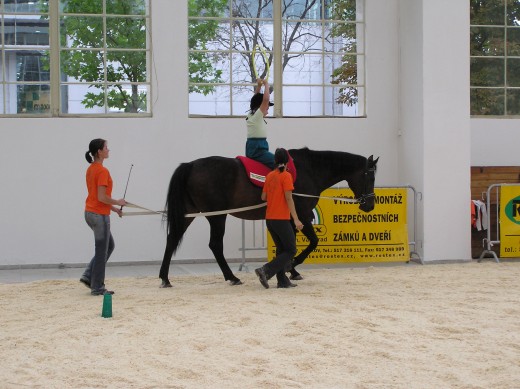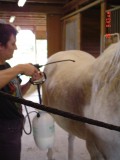Horse Therapy: Equine Facilitated Learning For ADHD and Autism
Some children are dealt a challenging hand the minute they are born. They can hugely be affected by a chemical imbalance in their bodies which they have no control over whatsoever. These imbalances can cause children to behave in an antisocial manner as they find it very difficult to communicate. This is particularly true for children who have been diagnosed with either Attention Deficit Disorder, or Autism.
In order to support children suffering from these ailments, American, Franklin Levinson, introduced Equine Facilitated Learning (EFL) to children with serious emotional challenges. Even though horse therapy has been around for ages, Levinson brought the idea to the next level by introducing it to difficult-to-handle children who exhibit antisocial behaviors.

Equine Facilitated Learning
Equine Facilitated Learning (EFL) is used for children who have trouble communicating and relating with other humans. When therapists use EFL, their purpose is not to teach the children how to ride or care for horses. The goal of the therapy is to help children learn about themselves and others with a focus on how to communicate calmly and clearly. It has been clinically proven that just being near horses changes our brainwaves and the experience brings on a calming effect.
People who participate in EFL are able to deepen their awareness of personal issues. They are able to take better control of their lives and learn about boundaries, limits, and control.

How EFL Works
The biggest factor about EFL that works for children and adults alike is the boost of self-esteem that occurs when people are working with horses. Horses are naturally defensive prey animals who are always on the lookout for predators. Horses are extremely fearful of people who are loud, rambunctious, and too controlling. In order to get a thousand pound horse to listen to commands is to be clear, concise, firm and gentle at the same time.
Horses tend to mirror what the human is doing and are therapeutic in the sense that they react to the human's emotions and behaviors immediately. The horses' reactions provide people with opportunities to think, reflect, and change their behavior instantaneously. Horses refuse to listen to humans unless commands are calmly requested rather than yelled at them or impulsively dictated to them. Through refinement of requests, children learn how to calmly communicate in order to get what they want. This translates, for children, to their everyday lives and they are able to take better control of their behaviors on a daily basis.
In addition, children
with attachment disorders also learn to relate closely with another
being. Relating well with a horse is a big step for children who can
then, in turn, apply their skills to humans and begin to relate well
with them too.
Based on what they know about horses,
therapists teach children to give horses commands and control them using
very simple, exact language. When a mentally or socially disturbed
child masters these commands, they feel they are in control of the horse
and start to build on their self-esteem. A combination of being in
charge and feeling good about themselves often helps children grow
emotionally through the process. Since children often see horses as
their equal rather than trying to take full control of them, they tend
to be more successful at EFL than adults. Horses also tend to react
better when they feel they are equal to the human rather than
subordinate.
Franklin Levinson found that...
"Children with ADD will focus on the horse for long periods while grooming or leading the horse when usually they can't concentrate long enough to do anything much. Autistic children who are withdrawn and living very much in their own world will begin to express themselves - often using new words or gestures they've never expressed before."
Children have to learn to control a horse through:
- mental focus,
- creative visualization, and
- clarity of intent.
The skills needed for mental focus, creative visualization, and clarity of intent are difficult to teach in a classroom within four walls. These skills are easily acquired when building a relationship with a horse.
Most activities associated with EFL are done on the ground. It is seldom that children end up on horseback for extended periods of time.
EFL Activities
EFL activities that children participate in can include:
- grooming the horse
- leading the horse through a course
- lunging ~ leading a horse around in a circle around you while giving it different commands
- saddling the horse
- telling the horse to stand still and start walking when you want
These activities allow children to really focus on their task at hand for an extended period of time. Children realize that the horses are depending on them so they tend to step it up and care for the equines appropriately. When children participate in the above activities successfully, they tend to feel very good about themselves and feel that they are able to accomplish something. Their self-esteem gets a positive boost.
Equine Facilitated Learning in Action
The Results
"Horse-facilitated activities help people recognize and move beyond the coping strategies associated with surviving in a competitive world. Participants in EFL develop a thriving mind set capable of endless compassion, innovation, energy adaptability, and creativity."
When children realize they can accomplish whatever they want when they put their minds to it, they begin to soar. Equine Facilitated Learning is one technique to help children realize and control their potential. EFL has given children with Attention Deficit Disorder focus and has opened up a communication door for those diagnosed with Autism.

Corporate Equine Faciliated Professional Development
Different organizations and businesses have turned to EFL as a way to bring cohesion to the workers. In order to build teamwork and collaboration, effective communication and collegiality, businesses are relying on the results of EFL to move their companies forward. EFL has helped personnel in a company:
- develop problem-solving skills
- communicate more effectively
- improve relationships
- develop leadership skills
- enhance collaboration
A Few Equine Facilitated Learning Programs
- Equine-Assisted Learning Programs - Innovative Horizons
Innovative Horizons - Instructor-led or facilitated programs on leadership, communications, and team building, utilizing horses as experiential team members. - Maui Horse Whisperer Experience
The Maui Horse Whisperer Experience combines horse whispering, equine facilitated learning, equestrian skill building and corporate training in leadership development and teambuilding; using the same well trained horses, Adventures on Horseback offer - Equine Facilitated Learning | Equine Faciliated Learning
Information on Equine Facilitated Learning - Coaching With Horses - Kathy Pike
Equine Facilitated Learning









